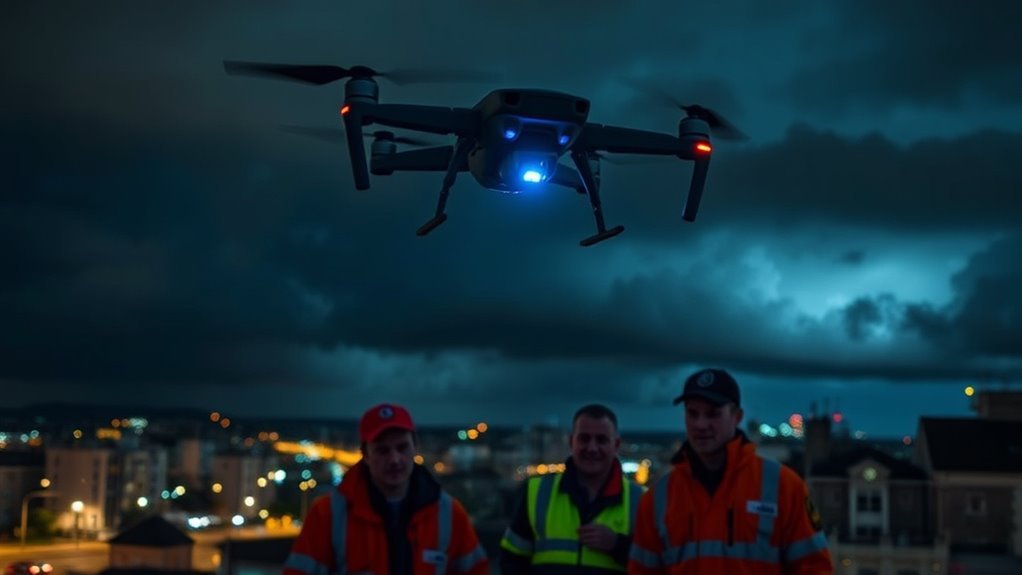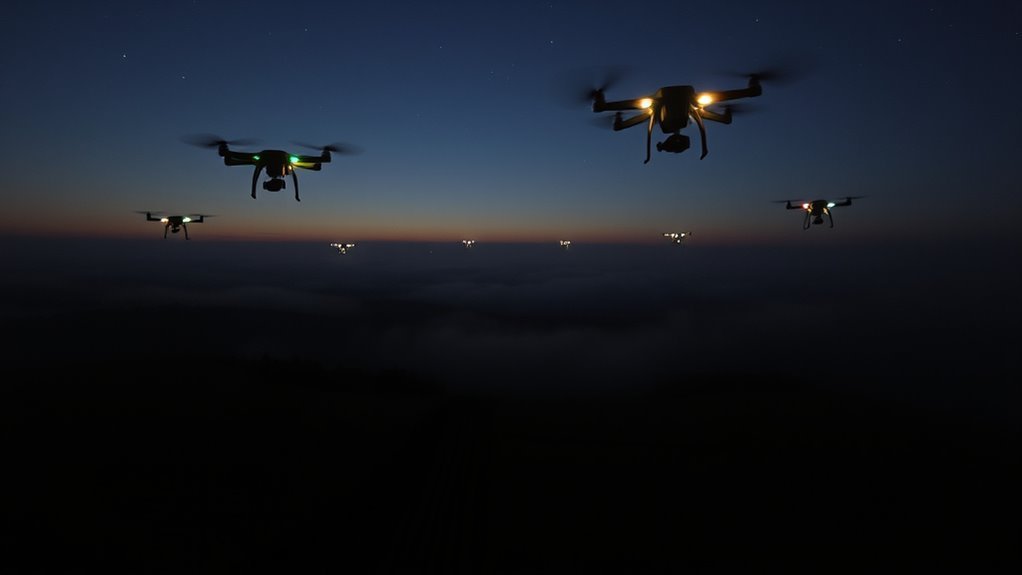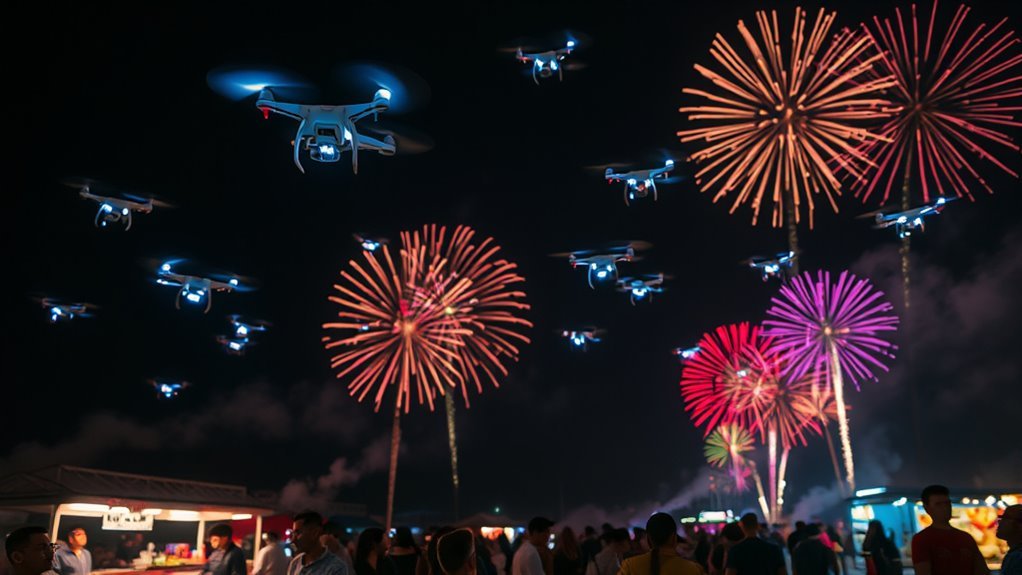Drones are flying around at night for several important reasons. They enhance law enforcement surveillance and assist in search and rescue missions, using thermal imaging to locate missing persons quickly. In agriculture, they monitor crop health and collect environmental data without disrupting activities. Drones also inspect infrastructure and assess pollution levels efficiently. Additionally, they’re used for security at events and recreational activities like night racing. There’s much more to explore about their diverse applications.
Law Enforcement Operations

As law enforcement agencies increasingly adopt advanced technologies, the use of drones at night has become an important tool in their operations. These unmanned aerial vehicles enhance surveillance capabilities, allowing officers to monitor large areas without the constraints of ground patrols. Drone technology provides real-time data, enabling law enforcement to respond swiftly to incidents, improving public safety. Night operations benefit from thermal imaging, which detects heat signatures, assisting in locating suspects or missing persons. This capability not only increases efficiency but also reinforces community trust, as citizens see proactive measures being taken to guarantee their safety. Additionally, the integration of advanced AI into drone operations can further enhance data analysis and decision-making processes. However, the use of drones must be balanced with privacy concerns, as maintaining civil liberties is vital in fostering a free society while safeguarding security.
Search and Rescue Missions

Law enforcement’s use of drones at night has paved the way for their application in search and rescue missions, a field where every second counts. When lives are on the line, these high-tech tools become invaluable. Equipped with thermal imaging and night vision capabilities, drones can locate missing persons in challenging environments. They can efficiently scan vast areas, detecting body heat even in complete darkness. This technology not only speeds up searches but also reduces the risks to ground teams. Imagine the relief of finding someone lost in the wilderness or during a disaster; drones make that possible. By harnessing these advanced capabilities, rescue operations can operate more effectively, ensuring that freedom and safety are restored swiftly and efficiently.
Agricultural Monitoring

While many might think of drones as tools for entertainment or photography, their role in agricultural monitoring is becoming increasingly essential. Drones equipped with advanced sensors can assess crop health with remarkable accuracy, providing farmers with real-time data. This technology supports precision agriculture by allowing you to monitor fields from above, identifying areas that need attention without stepping foot on the ground. Imagine being able to detect irrigation issues or pest infestations before they spread, all while saving time and resources. With the ability to fly at night, drones can gather data without disrupting daily farming activities. By leveraging these innovations, you’re not just improving yield but also embracing a more sustainable approach to farming. Additionally, using precision crop and pest detection technologies, farmers can optimize their spraying strategies and reduce chemical use, further enhancing environmental sustainability. Drones also enable real-time soil assessment, allowing farmers to analyze moisture, pH, and nutrient levels efficiently.
Infrastructure Inspections
Drones have become invaluable tools for infrastructure inspections, offering advantages that traditional methods simply can’t match. With advanced drone technology, you can achieve a level of inspection efficiency that’s not only faster but also safer. Think about it: instead of sending workers into potentially hazardous environments, drones can quickly assess bridges, power lines, and pipelines from above. They provide high-resolution images and real-time data, allowing for swift decision-making. Additionally, night operations further enhance their capabilities, revealing issues that daylight might obscure. This means you’re not just improving safety and reducing downtime; you’re also gaining the freedom to inspect at your convenience. As drone technology evolves, the potential for infrastructure inspections continues to expand, granting you unprecedented oversight and control, which is further enhanced by automated monitoring techniques that provide real-time data analysis. The integration of multispectral sensors in drones allows for more precise detection of structural anomalies, significantly enhancing inspection accuracy.
Event Surveillance and Security
As infrastructure inspections benefit from drone technology, event surveillance and security also see significant advancements. Drones equipped with high-resolution cameras and night vision capabilities enhance safety at large gatherings. Here are some key benefits of using drone technology in event security:
- Real-time Monitoring: Drones provide live feeds, allowing security teams to respond promptly to incidents. Enhanced analytical overlays assist in quick scene interpretation for better outcomes.
- Crowd Management: They help monitor crowd behavior, identifying potential issues before they escalate.
- Access to Hard-to-Reach Areas: Drones can easily survey areas that ground personnel might find challenging to access.
- Cost-Effective Solutions: Utilizing drones reduces the need for extensive ground security personnel, optimizing event security budgets.
Incorporating drone technology into event security not only guarantees a safer environment but also aligns with the desire for freedom and innovation in protecting public spaces. Additionally, the use of drones enhances real-time monitoring capabilities, ensuring a proactive approach to security management.
Environmental Research
When it comes to environmental research, flying drones at night opens up unique opportunities for data collection that daytime methods can’t match. You can monitor wildlife behaviors without disturbing their natural patterns, assess pollution levels with minimal interference, and gather critical nighttime data that enhances your understanding of ecosystems. This approach not only improves research accuracy but also helps in developing more effective conservation strategies.
Nighttime Data Collection
While many may think of drones as daytime tools, their capabilities extend well into the night, providing unique advantages for environmental research. Using night vision and thermal imaging, drones can collect critical data that would be challenging to obtain during daylight hours. Here are some key benefits of nighttime data collection:
- Enhanced visibility: Night vision technology allows for clear imaging in low-light conditions.
- Temperature analysis: Thermal imaging captures heat patterns, revealing hidden environmental issues.
- Reduced disturbance: Operating at night minimizes disruptions to wildlife and ecosystems.
- Broader data range: Nighttime flights can provide insights into nocturnal species and behaviors.
These advantages empower researchers to gather extensive data, ultimately supporting a more profound understanding of our environment.
Wildlife Monitoring Applications
Drones have revolutionized wildlife monitoring by providing researchers with the tools to observe and study animal behavior in their natural habitats without intrusive presence. With advanced imaging technology, you can engage in precise habitat mapping, identifying critical areas for conservation. This method allows for a broader understanding of species distribution and ecosystem health. Additionally, drones facilitate species tracking, enabling researchers to gather real-time data on animal movements and behaviors, which is essential for effective management strategies. By minimizing human interference, drones enhance your ability to monitor wildlife patterns, ensuring the preservation of biodiversity. As you utilize these tools, you’re not just observing; you’re actively contributing to the protection of wildlife and their habitats.
Pollution Assessment Techniques
As you harness the capabilities of drones for wildlife monitoring, consider their significant role in pollution assessment techniques as well. Drones provide unparalleled insights into air quality and urban analysis, enabling real-time data collection that can drive informed decisions. Here are four key pollution assessment techniques you might explore:
- Airborne Sensor Integration: Drones equipped with sensors can detect pollutants, providing immediate feedback on air quality.
- Thermal Imaging: This technique helps identify heat signatures from industrial sources, pinpointing pollution hotspots.
- Geospatial Mapping: Drones create detailed maps, allowing for spatial analysis of pollution sources in urban areas.
- Temporal Monitoring: Night flights enable continuous pollution tracking, capturing variations in air quality over time.
Embracing these techniques empowers you to advocate for a healthier environment.
Recreational and Entertainment Uses
When night falls, the world transforms, offering a unique canvas for recreational drone enthusiasts to explore. You might find yourself captivated by the thrill of drone racing under the stars, where illuminated drones zip through darkened courses, creating a breathtaking spectacle. The excitement of competition is heightened at night, as the glowing lights enhance the challenge and allure of the race.
Additionally, night photography presents an incredible opportunity for you to capture stunning visuals. Drones equipped with high-quality cameras can reveal the beauty of cityscapes and natural landscapes illuminated by moonlight. This blend of technology and creativity not only satisfies your desire for freedom but also allows you to express yourself artistically in a way that’s uniquely yours.
Frequently Asked Questions
Are There Regulations for Flying Drones at Night?
Over 60% of drone operators report flying at night without proper knowledge. You’ll find that nighttime regulations focus on drone safety, requiring lights and adherence to visual line-of-sight principles to guarantee a secure flying environment.
What Technology Do Nighttime Drones Use for Visibility?
Nighttime drones often utilize night vision technology and infrared sensors, allowing you to capture clear imagery in low light. These advancements enhance surveillance capabilities, ensuring that you can maintain visibility and monitor areas effectively after dark.
Can Drones Fly Over Private Property at Night?
Drones can fly over private property at night, but privacy concerns and property rights often come into play. It’s important to understand local regulations and your rights to guarantee you’re not infringing on anyone’s space.
How Do Drones Avoid Collisions in the Dark?
As the saying goes, “better safe than sorry.” Drones employ advanced collision avoidance systems and night navigation technologies, utilizing sensors and algorithms to detect obstacles, ensuring they fly safely even in low-light conditions.
Are Nighttime Drone Flights More Expensive Than Daytime?
Nighttime drone operations often incur higher costs due to additional safety measures and lighting requirements. You’ll find that these nighttime costs can affect overall budgeting, impacting how you plan for drone activities effectively.

